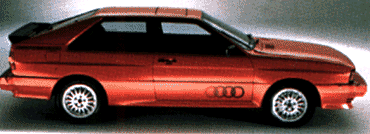
First things first. Coupé is the past participle of the French verb couper, which means to cut. When referring to a car, coupé is the short form of the older term, carrosse coupé, which means shortened carriage. Today, coupé translates as a closed car with a shortened body. So, while coupé has come to be applied to smaller two-door cars, the word does not seem to imply anything about the number of doors.

Audi launched it's new quattro AWD system fitted to a two-door coupe at the Geneva Motor Show in 1980. The ur-quattro, as it came to be known years later, took the world's rally circuits by storm. The design of the car remained largely unchanged for an entire decade. I will not try to cover the history and prestige of this car here. You can find out more at Robert Houk's ur-q Page, and the Ultimate ur-quattro Home Page.
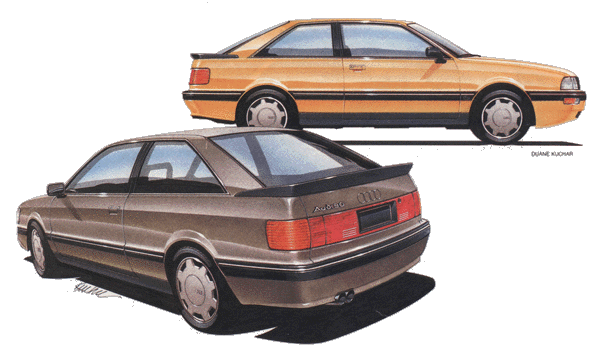 In the late
'80s Audi was trying to recover it's image in the United States after the
disatrous handling of the 60 Minutes "unintended acceleration" story.
The Coupe GT and
Quattro were beginning to age, so Audi decided to update the styling and
technology and create an entirely new coupe. The November 1987 issue of
Motor Trend peeked into the future with a report of a new coupe, a
top-of-the-line V8 (predicted to be called a "300"), and a limited production
supercar.
In the late
'80s Audi was trying to recover it's image in the United States after the
disatrous handling of the 60 Minutes "unintended acceleration" story.
The Coupe GT and
Quattro were beginning to age, so Audi decided to update the styling and
technology and create an entirely new coupe. The November 1987 issue of
Motor Trend peeked into the future with a report of a new coupe, a
top-of-the-line V8 (predicted to be called a "300"), and a limited production
supercar.
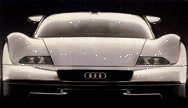
While the Avus show car never went into production, the V8 became very much a reality, as did the 80/90 based coupe. The drawings at right (taken from that MT issue) show a preliminary design. Obviously, it is just a 90 body with no rear doors and a slightly more sloped rear window. Notice that the trim moldings are black, while the rear valance and front spoiler are body color.
By the time the May 1988 issue came out, MT had a picture of the new coupe, although it was still a very early prototype. The accompanying article states:
"the Coupe is visibly stubbier than the 80/90 sedans, with 5.9 in. cut out of the body length aft of the rear wheels."
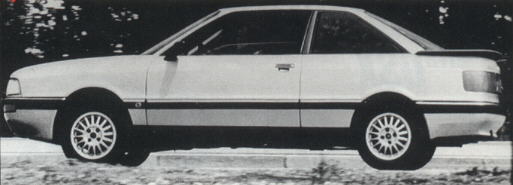 The production
coupe was actually only 0.3 inches shorter than the sedan, but with a 0.5
inch longer wheelbase. Notice the narrow B-pillar in this prototype. It appears
that this is basically juat a 90 with different doors.
The production
coupe was actually only 0.3 inches shorter than the sedan, but with a 0.5
inch longer wheelbase. Notice the narrow B-pillar in this prototype. It appears
that this is basically juat a 90 with different doors.
The article goes on to say:
"although the trunk is rather small, the low-reaching hatchback door does allow easy access."
The low-reaching door was a holdover from the sedan, but it was later changed to open between the spoiler and the taillights. I assume the weight of the hatch was too great with the center section of the taillights attached. Audi further reduced the hatch's weight by constructing the frame entirely from fiberglass. The picture also shows front and rear bumpers, spoiler, and skirts from the 90, as well as the older-style 14 inch ronal wheels, all of which would be changed before the Coupe was released.
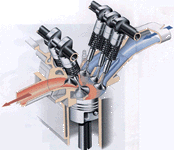 The final version
of the Coupé Quattro arrived in North America in late '89 (as a '90
model). It had gone through many refinements, and the final version shared
very little sheet metal with the sedan. It was also very different from the
original quattro coupe. All the body panels were fully galvanized for rust
prevention. The five cylinder engine remained, but the turbocharger was gone.
Instead, the new engine made power with fully electronic multi-port fuel
injection and four valves per cylinder (borrowing designs from the 16V
Volkswagen GTI and 32V Audi V8), a precursor to the now-current five valve
design pictured at right. While this engine was the most powerful normally
aspirated 5-cylinder engine Audi ever produced, it was still a bit underpowered
for the weight of the car.
The final version
of the Coupé Quattro arrived in North America in late '89 (as a '90
model). It had gone through many refinements, and the final version shared
very little sheet metal with the sedan. It was also very different from the
original quattro coupe. All the body panels were fully galvanized for rust
prevention. The five cylinder engine remained, but the turbocharger was gone.
Instead, the new engine made power with fully electronic multi-port fuel
injection and four valves per cylinder (borrowing designs from the 16V
Volkswagen GTI and 32V Audi V8), a precursor to the now-current five valve
design pictured at right. While this engine was the most powerful normally
aspirated 5-cylinder engine Audi ever produced, it was still a bit underpowered
for the weight of the car.
 The original quattro
system had been refined, as well. The formerly manual locking center differential
was replaced with a TORSEN (TORque SENsing) unit. This allowed for automatic
power distribution between the front and rear driveshafts. The rear differential
remained manual locking, but gained an automatic disengage feature once the
car began to move at typical road speeds. New safety features included ABS
brakes, PROCON TEN (PROgrammed CONtraction and preTENsioning
system) seatbelt tensioners and collapsable steering column (pictured
at left), and a driver's airbag.
The original quattro
system had been refined, as well. The formerly manual locking center differential
was replaced with a TORSEN (TORque SENsing) unit. This allowed for automatic
power distribution between the front and rear driveshafts. The rear differential
remained manual locking, but gained an automatic disengage feature once the
car began to move at typical road speeds. New safety features included ABS
brakes, PROCON TEN (PROgrammed CONtraction and preTENsioning
system) seatbelt tensioners and collapsable steering column (pictured
at left), and a driver's airbag.
Much like the original quattro, the Coupé Quattro had a dismal sales record in the U.S. despite all of its high-tech features. In the late '80s and early '90s, Audi's reputation was at an all time low, and there weren't many people who were willing to shell out $30K for a luxury touring coupe. In fact, Audi says that only 1,730 Coupe Quattros were sold in North America. By contrast, Audi produced a total of 73,858 B3 model Coupes from 9/87 to 1/96, including many FWD models and 7,370 S2 models. Unfortunately, lack of North American interest in the CQ ensured that Audi would not bother to certify and import the S2 -- the real successor to the ur-quattro. Luckily, time has been kind to most of the CQs that did find a home in the U.S. The design is still more modern than many of today's offerings, and thanks to galvanized body panels and traditional robust German engineering, these cars still have plenty of life in them.